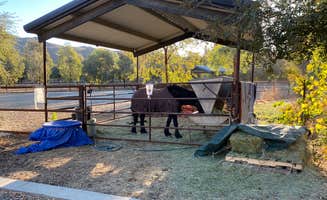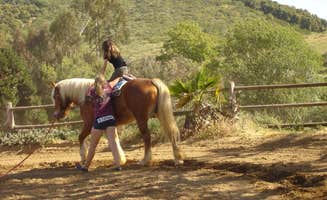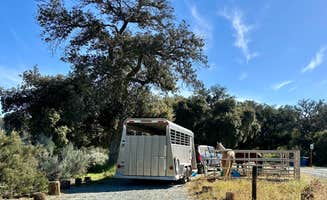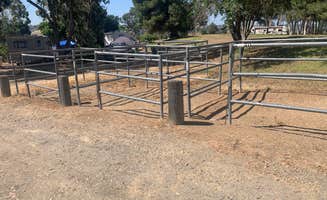Equestrian camping options near Warner Springs provide access to mountain trails at elevations between 3,000 and 6,000 feet. The terrain varies from arid desert landscape to pine forests with temperature ranges of 40-80°F during spring and fall riding seasons. Trail difficulty ranges from beginner-friendly flat paths to steep mountain ascents requiring experienced riders.
What to do
Trail riding to mountain peaks: The riding trails near Cuyamaca Rancho State Park offer varied terrain for horseback riders. "Lots of sites to choose from. Plenty of animal and bird watching. Star gazing is amazing as well. I have camped here in fall, spring and summer. I have never been disappointed," notes Loren D. The park connects to multiple trail systems with elevation gains of 500-1,500 feet.
Fishing access with horses: Several equestrian campgrounds provide direct access to fishing lakes within short riding distance. At Lake Skinner Recreation Area, campers can combine riding and fishing. "The lake is stocked with fish throughout the year, but they require you to buy a riverside county lakes fishing permit for each day if you want to fish," explains Timothy A. Daily fishing permits cost $10 per person.
Mountain biking on shared trails: Many equestrian trails in the region permit mountain biking on designated routes. "There is a bike trail around the lake and fishing. Playgrounds and other child friendly activities available upon request," reports Sam T. from Lake Cahuilla. Riders should expect to encounter cyclists particularly on weekends and follow proper trail etiquette when passing.
What campers like
Spacious sites for horse trailers: Equestrian sites typically provide extra space for trailers and corrals. At Dripping Springs Campground, "sites all have a table, fire ring and grill... we had campsite #29 which seems to be one of the better ones along with #33 and #8," says Tyler B. The campground's equestrian sites feature level parking areas for trailers up to 40 feet.
Night sky visibility: The dark skies in this region offer excellent stargazing from horse camps. "Dark, beautiful skies at night. Good hiking trail into the mountains, with the trailhead near the entrance to the campground," writes Patrick M. about Lake Cahuilla. Most equestrian campgrounds maintain minimal artificial lighting to preserve night sky viewing.
Seasonal wildflower viewing: Spring brings wildflower displays along many equestrian routes. "We happened to be there during the poppy super bloom and the butterfly migration so that was also really cool!" shares Jennifer D. about Lake Cahuilla. Peak wildflower season typically runs from late February through April, depending on winter rainfall.
What you should know
Trail conditions vary by season: Seasonal changes significantly impact trail riding conditions. "This is a great campground all year long. You feel like you are in the middle of nowhere even though there is a small mountain town 20 minutes away," explains Loren D. Spring offers the most reliable trail conditions, while summer trails can become dusty and fall trails may be hard-packed.
Limited shower facilities: Most horse campgrounds have minimal or no shower facilities. At Green Valley Campground, "Bathrooms and showers were decent and relatively clean...showers do cost 25 cents for 2 minutes!" reports Joseph W. Riders should bring quarters for pay showers or plan for alternative washing options.
Permit requirements: Some trail systems require day-use permits in addition to camping fees. "The campground is at the trailhead of a popular trail and gets crowded during the weekends. I do not recommend camping here if you're looking for peace and quiet," advises Jason H. about Dripping Springs. Weekend trail permits should be secured in advance during peak spring and fall seasons.
Tips for camping with families
Kid-friendly water features: Several campgrounds offer water play areas for children. "They have a super nice splash pad park that's no additional cost! There are lots of walking trails," notes Jennifer D. about Lake Skinner Recreation Area. This splash pad operates seasonally from May through September.
Wildlife viewing opportunities: Families can observe diverse wildlife from many horse camps. "Tucked away from the city lights of San Diego. Very nice camp ground with multiple trails climbing up Mt. Cuyamaca," writes Zachary M. about El Prado Campground. Morning and evening hours provide the best wildlife viewing times, with wild turkeys, rabbits, and deer commonly sighted.
Safe riding areas for beginners: Several campgrounds offer beginner-friendly riding areas for children. "The sites are cute and back up to old Oak growth and chaparral forest," explains Andy H. about Dripping Springs Campground. Designated practice areas with flat terrain are available near most equestrian campsites for young riders to practice before hitting trails.
Tips from RVers
Water and electrical connections: Not all equestrian sites provide full hookups. At Stagecoach Trails Resort, "Beautiful location, secluded, lots of space to get a big trailer in. It's off the beaten path," reports Dustin A. RV sites with horse accommodations typically offer 30-amp service and water hookups, with dump stations available at central locations.
Road access considerations: Mountain roads to horse camps can present challenges for larger rigs. "Limited 30/50 amp full-hookups. Large rigs, beware. Access roads are narrow, hilly, AND curvy. But, it CAN be done," cautions John D. about Oakzanita Springs. RVers should research specific route conditions for trailers over 30 feet.
Temperature management: Mountain elevations experience significant temperature swings. "Wouldn't come again this time of year without a heater, as it got uncomfortably cold at night," notes Jessie W. RVers should prepare for overnight temperatures that can drop 20-30 degrees below daytime highs, particularly at higher elevation campgrounds.





